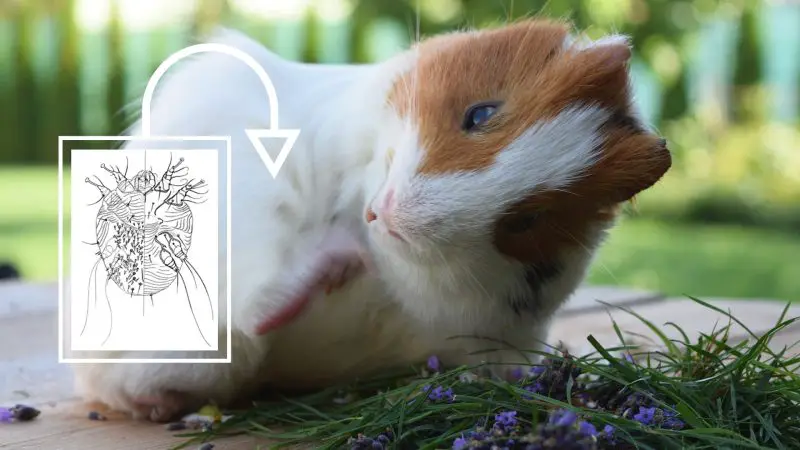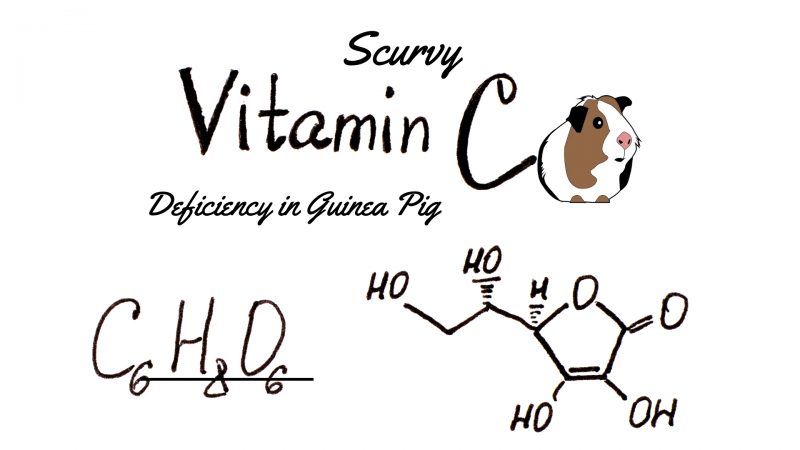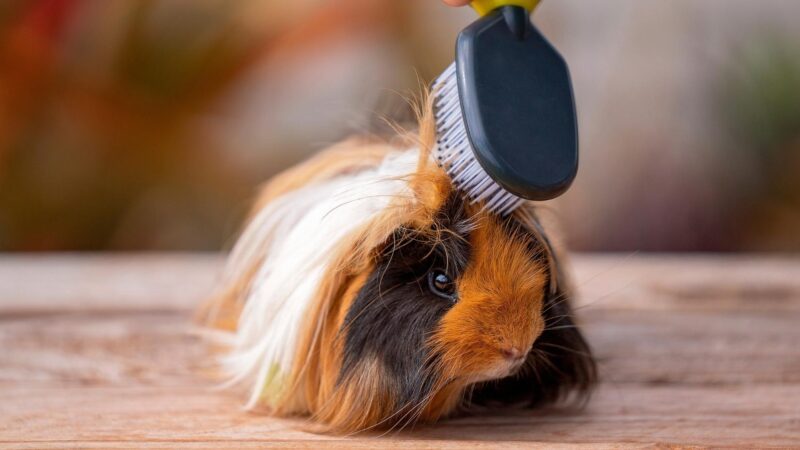If you’ve ever had dogs or cats, you’re probably used to a lot of shedding, especially if we talk about long-haired dogs. They often shed so much, that you can fill a bigger bag with the fallen hair. Now let’s talk about our guinea pigs.
Just like almost every domestic animal with hair, guinea pigs do naturally shed. In some cases, they can also shed heavily, especially in spring, when the weather starts to warm up. However, there are other health conditions that can cause guinea pig hair loss, such as mange mites, fungal infections and vitamin C deficiency.
Why Do Guinea Pigs Shed?
Guinea pigs are naturally supposed to shed. But, as you already know, guinea pigs can be victims of parasites, fungus, and other health conditions that may produce this effect. In this section, we’ll take a look at some of the most common health problems that produce shedding in guinea pigs.
Mange Mites

Mange mites are very dangerous microscopic mites that burrow under the skin of your guinea pig and cause gut-wrenching pain. While ordinary infestation can be treated quite easily, a severe one can cause death.
The first signs that your guinea pig has mange mites include biting, scratching, hair loss, and seizures. If you notice that your guinea pig has mange mites, treat it as soon as possible, especially if you have other guinea pigs inside the cage. This is because mange mites can be transferred to the other pigs. If not treated, you could have a whole pack of pigs dead.
Some methods can drastically reduce mite infestations. The ivermectin injection is a great cure for this but it can also be used orally or topically.
This medicine is also safe for pregnant guinea pigs, but it is not recommended for pigs under 12 ounces. There are other cures for this condition but in our opinion, this is the most effective one. After all, you’ll still want to visit the vet and let him evaluate the situation.
Fungal Infections
In most cases, fungal infections start on the face, so the hair loss begins from there. The face is patchy and for your guinea pig, it’s very itchy. From there, the fungal infection might spread to other body parts such as limbs or back, especially when it’s warm weather.
You’ll easily notice fungal infections as they have the characteristic look in form of dry scabs with no hair above them. Fungal infections can also be carried to other animals or in this case, other guinea pigs, meaning that it should be treated right away.
There are numerous factors which can be a cause of fungal infections. They include the environment, diet, stress, humidity, heat, genetics, and crowding. To prevent the fungal infections, be sure to keep your guinea pig away from humid areas and always keep the guinea pig cage clean. The treatment of this condition can depend on the type of fungal infection and there’s not a single cure that helps all type of fungal infections.
Vitamin C Deficiency

Vitamin C is the most important micronutrient in your guinea pig’s diet. Guinea pigs can’t produce vitamin C by themselves. Hence, it must be included in the diet. The main symptom of vitamin deficiency includes lethargy, loss of appetite, loss of weight, diarrhea, rough coat, and of course, hair loss. You can easily prevent vitamin C deficiency by including the right amount of it in your guinea pig’s diet.
Veterinarians recommend that you go with anywhere between 10 and 30 mg/kg a day. For pigs with vitamin C deficiency or pregnant pigs, the recommendation is minimum 30mg/kg or above.
Hormonal Hair Loss
Hormonal hair loss is the most common in female guinea pigs during their pregnancy and lactation periods. The reason for this is the ovarian cyst, associated with pregnancy.
Sows that have been bred intensively might experience hair loss in the last trimester. Frequent breeding will exacerbate the hair loss during pregnancy and lactation because of the reduced anabolism of maternal skin, caused by fetal growth.
How to Manage Guinea Pig Hair Loss?

Now that you know the possible causes of hair loss, including the natural cause, it’s time to see how to keep it under control.
Brush Your Guinea Pig Often
The only way to reduce the shedding to a minimum is to brush the pig regularly. We recommend brushing at least once per week, but even two times per week is great. This will help your guinea pig get rid of its old hair and make a place for the new one.
However, the main mistake is that owners tend to brush the guinea pig too heavily. You don’t need Hulk’s strength to brush the pig. Go gently and never scrape the brush over too strongly or over patches of skin. Guinea pigs are very sensitive and so is their skin, which can be easily damaged.
Additionally, the brush should be very soft. We recommend using a baby brush or a greyhound comb. These will successfully remove loose hair, thus keeping your guinea pig’s hair healthy and shiny. The same will apply to guinea pigs with longer hair, with the difference in brushing being. You have to brush it longer to avoid tangling. You can check out grooming kits that we recommend for guinea pigs.
Clean the Cage Regularly
Keep your guinea pig’s cage clean at all times. This will determine the health of your guinea pig but also its lifespan. Guinea pigs don’t get immunizations like cats and dogs, and every piece of dirt in your cage can cause troubles. As a result, a guinea pig can develop some of the conditions we’ve mentioned above and these conditions can be quite severe.
To properly clean it, avoid using strong chemical cleaners. Instead, use water in combination with a mild or baby soap. Alternatively, you can use a mixture of vinegar and water. When you finish the cleaning, make sure that the cage is completely dry before putting your pig back inside.
Improve the Diet
If your guinea pig isn’t healthy, chances are that either its cage isn’t clean or its diet isn’t proper. When it comes to the diet, we can’t say it’s too complicated. Focus on hay because this is the primary food of your guinea pig. Around 80% of its diet needs to be hay and the other 20% can be vegetables and a bit of fruit. T
he interesting thing is that guinea pigs also need a bit of protein, around 15% of the diet. For that purpose, we recommend Timothy-based pellets. A 1/8 cup per day should be enough for a grown-up guinea pig
Buy a De-Shedding Tool
A de-shedding tool is a metal comb for catching loose hair when you brush your pet. These tools are often used for cats and dogs but can also be used for guinea pigs. We recommend that you buy a small de-shedding tool tailored toward kittens. Only be sure to use it gently because its brushes are quite rough.
- Best pet grooming tool! Leave behind the grooming headache, removing up to 95% of dead hair and tangles from your cat and dog easily IN JUST 10 MINUTES! Keep your furniture and floors free of pet hair while SAVING MONEY and TIME on expensive visits to the vet for pet grooming services! Get valuable grooming tips on the ‘Four Dog Care’ FREE E-book!
- A durable shedding tool! This dog and cat comb is MADE TO LAST through long years of effortless pet grooming! With the 100mm STAINLESS STEEL BLADE protected by a cover for your safety and the blade longevity and the STURDY, EASY-GRIP HANDLE, it promise top precision. It is a long-lasting deshedding tool, a MUST-HAVE pet hair remover!
- Healthy, shiny pet coat! Rid your four-legged friend of undercoat and loose hair effortlessly, and keep at bay allergies by frequently brushing them! Have your pet thankful for the professional services of a dog/cat deshedding tool and establish strong bonds between you and your four-legged friend!
- TA Thoughtful gift to all pet owners! Easy to use and causing not a speck of discomfort, this grooming brush will put a wide smile on the face of the lucky pet owner! It will relieve their dog or cat from shedding, trimming pet grooming time to just 10 minutes. Offer it on all occasions to save them time, money and effort and show off your excellent taste!
- 100% SATISFACTION: All Pet Neat products are satisfaction for life. Click Add to Cart now!
Eliminate Stress out of Your Pig’s Life
Many people die indirectly from stress, as this condition can be a cause of much more serious health conditions. Guinea pigs can also be stressed, even easier and more often than humans. As rodents, they were never made to hunt the prey but to be the prey instead. This instinct is preserved even today, which is why your guinea pig needs to feel safe and secure.
The cause of stress can be even the most ordinary things. For example, other guinea pig can bully the weaker pig, which should tell you that these two pigs aren’t good together. You can then split them and make the pig’s life easier.
Another example is a loud place, where a lot of things happen during the day. Guinea pigs love silence and they would gladly enjoy an empty room with no noises than your kitchen or living room where you watch TV and talk with your family. Give it a quiet room and the stress will disappear.
Hair loss is a pretty common condition that occurs in every animal. But, we still need to consider other causes which are mentioned in the article. If your guinea pig starts losing hair abruptly, you should immediately visit your vet.
Always keep your guinea pig clean, full, healthy, and stress-free. This sentence encapsulates everything that we talked about and is key to avoid unnatural hair loss.
List of Sources
Caring for Your Pet Guinea Pig
Common Mites of Your Rabbit and Small Animal Part
Nutrient Requirements of Laboratory Animals: Fourth Revised Edition
The Effects of Diet on Anatomy, Physiology and Health in the Guinea Pig

